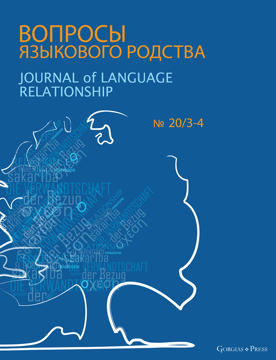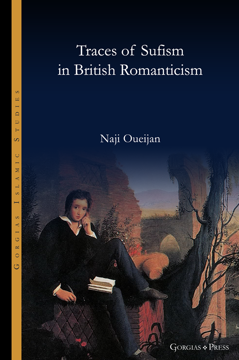The Archaeology of Hatra, the Sacred City
ISBN: 978-1-4632-4547-4
A study of the archaeology, history, architecture, sculpture and divinities of the ancient city of Hatra.
$95.00 (USD) $57.00 (USD)
Journal of Language Relationship 20/3-4
Editor-in-Chief Vladimir Dybo; Managing Editor George Starostin; Editorial Secretary Tatiana Mikhailova; Editorial Board Anna Dybo, Manuel Molina, M. N. Saenko & Ilya Yakubovich
Series: Journal of Language Relationship 20/3-4
ISBN: 978-1-4632-4550-4
The Journal of Language Relationship is an international periodical publication devoted to the issues of comparative linguistics and the history of the human language. The Journal contains articles written in English and Russian, as well as scientific reviews, discussions and reports from international linguistic conferences and seminars.
$74.00 (USD) $44.40 (USD)
Traces of Sufism in British Romanticism
Series: Gorgias Islamic Studies 20
ISBN: 978-1-4632-4552-8
This work argues that there are traces of Sufism to be found in British Romanticism. Most scholars of Romanticism have overlooked the impact of Sufism on Romanticism in favour of Christian and neo-Platonic Mysticism, but this work fills in this gap by showing the magnitude of the influence of Sufism on the Romantics without negating the influence of other -isms. What elements of Sufism attracted the attention of the Romantics? And why were the Romantics attracted more to Sufism and Sufi poets than to Christian Mysticism and Mystic poets?
$95.00 (USD) $57.00 (USD)
Sacred Space in Syriac Orthodox Liturgy
A Ritual and Theological Perspective
Series: Gorgias Eastern Christian Studies 66
ISBN: 978-1-4632-4555-9
A study of how the Sedrō of Entrance has been practiced in earlier periods and architectural contexts and to investigate what role the entrance rite may have had in constructing the sanctuary as sacred space and the worshipping community as church.
$95.00 (USD) $57.00 (USD)
Celebrating the Holy Saints
The Origin, Evolution, and Liturgical Use of the Mälkəʿ
Series: Gorgias Eastern Christian Studies 67
ISBN: 978-1-4632-4557-3
This book explores the somatic hymns – Mälkəʿ – addressed to saints in the Ethiopian and Eritrean Churches, their origin and development, and transmission and use in the present day. This vast and hitherto untapped collection of hymns are an important source for an accurate understanding of the Church’s spirituality, hagiography, and liturgy.
$95.00 (USD) $57.00 (USD)
Priscillian
The Life and Death of a Christian Dissenter in Late Antiquity
ISBN: 978-1-4632-4559-7
The first historical biography of Priscillian, a controversial figure of great importance for the history of the West, who until now has been considered by the different authors who have approached his figure as a heretic, reformer, apocryphal martyr or non-conformist Christian.
$85.00 (USD) $51.00 (USD)
Three Persian Martyr Acts
The Acts of Miles, Bishop of Susa, the Priest Abursam, and Deacon Sinai, The Martyrdom of Zebina and his Companions, and The Martyrdom of the Forty Martyrs of Beth Kashkraye
Edited with an Introduction by Susan Ashbrook Harvey, Professor Reyhan Durmaz, Michael L. Payne, Prof. Daniel Picus & Noah Tetenbaum
ISBN: 978-1-4632-4561-0
This volume brings together the texts and translations for three Syriac martyr acts, set in Sasanian Persia during the reign of Shapur II (309-379 CE). These texts offer compelling witness to the challenges of a community’s need to honor memory and experience, and evidence towards the formation and sustenance of Christian identity in the midst of Persian society and culture.
$74.00 (USD) $44.40 (USD)
The Text of the Synoptic Gospels in the Writings of Origen
Series: Texts and Studies (Third Series) 30
ISBN: 978-1-4632-4563-4
A study of the citations from the synoptic gospels that occur in the works of Origen that have survived in Greek. The citations, lemmata, adaptations and allusions have been collected and citations and lemmata compared against a selection of known manuscripts representing major text types including the so-called Caesarean text type.
$149.00 (USD) $89.40 (USD)
A New Buddhist Hybrid Sanskrit Reader
By Professor Boris Oguibénine; Contribution by Dr. Katarzyna Marciniak
Series: Harvard Oriental Series - Opera Minora 15
ISBN: 978-1-4632-4566-5
Buddhist Hybrid Sanskrit is not a deteriorated Sanskrit (as many believed at the discovery of Buddhist texts in Sanskrit), but, following the theoretical foundations underlying the pioneering work of Franklin Edgerton, a language with its grammar and vocabulary sui generis implemented rather consequently, which for a long period of time was used to spread the teaching of Buddha. The Reader is meant as a textbook for advanced students with an interest in non-standard Sanskrit and Middle Indo-Aryan. A substantial novelty of the Reader is that it includes extracts from representative texts either recently critically re-edited on the basis of new manuscripts or from the texts unknown at the time of Edgerton’s publications. All extracts are accompanied by commentaries explaining their grammatical peculiarities as well as by selections of specific lexical items.
$135.00 (USD) $81.00 (USD)
Circumcision and Jewish Identity
Case Studies on Ancient Texts and Their Reception
Edited by Lieve M. Teugels & Karin B. Neutel
Series: Judaism in Context 33
ISBN: 978-1-4632-4579-5
Male circumcision is one of the oldest and most widespread rituals, it has been practiced for millennia across many parts of the world. Yet this prevalence and long history do not make circumcision self-evident: it has also long been a topic of reflection, discussion, and controversy and continues to be so today. As the cases in this volume show, already in Antiquity, Greeks, Romans, Jews and Christians clashed over male circumcision. Then as now, concerns about identity, ritual, health, masculinity, and sexuality were a factor in these disputes. Very little is known about actual circumcision practices in the ancient world. Apart from depictions in art, the relation of which to daily practice is difficult to ascertain, we have historical access mainly through texts that reveal how the practice was discursively constructed, and that relate circumcision to wider cultural practices and ideas. This book therefore mainly discusses references to circumcision in literary sources, and the way these relate to other known cultural practices and ideas. These sources date from biblical times and Antiquity and their interpretations in medieval Jewish texts and recent scholarship.
$95.00 (USD) $57.00 (USD)









